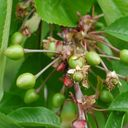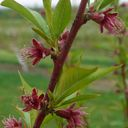Current (through May 16) degree day (DD) Accumulations
Location: UMass Cold Spring Orchard (CSO), Belchertown, MA
Base 43: 436
Base 50: 241
Significant upcoming orchard insect events based on degree days (Base 43):
Spotted tentiform leafminer sap-feeders present: 343-601
Oriental fruit moth 1st flight peak: 350-552
Lesser appleworm 1st catch: 263-567
Codling moth 1st catch: 400-578
Plum curculio oviposition scars present: 485-589
McIntosh at petal fall: 443-521
Current bud stages
| Location |
McIntosh apple -- |
Gold Bosc pear -- fruit set |
Burgundy (Pearl) cherry -- fruit set | PF14 Jersey peach -- petal fall |
|---|---|---|---|---|
| Belchertown UMass CSO (05/16/11) |
 |
 |
 |
 |
Note: this will be the last current bud stage update for 2011
Orchard Radar insect synopsis
Note: with each issue of Healthy Fruit we will be reprinting apple insect degree-day model highlights from Glen Koehler's (U. of Maine) Orchard Radar output for Belchertown, MA.
- 1st Lesser Apple Worm (LAW) flight begins around: May 11, Wednesday. Peak trap catch: May 21.
- 1st generation Oriental Fruit Moth (OFM) flight starts: May 3, Tuesday. 1st generation - 55% egg hatch and first treatment date, if needed: May 30, Monday.
- Increased risk of Plum Curculio (PC) damage as McIntosh and similar cultivars increase fruit size:
May 21, Saturday. Earliest safe date for last PC insecticide spray: June 1, Wednesday. - San Jose Scale (SJS) first adult caught on trap: May 19, Thursday.
- Spotted Tentiform Leafminer (STLM):1st STLM flight, peak trap catch: May 12, Thursday. 1st generation sapfeeding mines start showing: May 23, Monday. Optimum sample date is around Tuesday, May 24, when a larger portion of the mines are visible.
- 1st generation White Apple Leafhopper (WAL) found on apple foliage: May 14, Saturday
- Wednesday, May 11 McIntosh full bloom; Wednesday, May 18 95% petal fall; Thursday, May 19 100% petal fall; Monday, May 23, fruit set
- Estimated apple sensitivity to chemical thinners: Increased sensitivity, May 18-20; Stronger influence for increased sensitivity, May 21-22; Increased sensitivity, May 23-24.
Upcoming meetings
May 17, 18, 19: Tree fruit twilight meetings
May 17, UMass Cold Spring Orchard, 391 Sabin St., Belchertown, MA.
May 18, Lavoie's Farm, 172 Nartoff Rd., Hollis, NH.
May 19, Narrow Lane Orchard, 213 Narrow Lane, North Kingston, RI.
Tree fruit twilight meetings start promptly at 5:30 PM.
Pesticide recertification credit(s) will be offered.
There will be a $25 meeting admission charged at the door. (MA and RI meetings only. $20 for Massachusetts and Rhode Island Fruit Growers' Association FULL members.)
A light meal or snack is typically served at all meetings.
May 20: UMass Good Agricultural Practices Training, Berkshire Room, University of Massachusetts Collaborative Services Facility, 333 South Street, Shrewsbury, MA 01545-4169. Pre-registration required at dyork@umext.umass.edu.
June 14, 15, 16: Tree fruit twilight meeting, TBA
July 18, 2011: Massachusetts Fruit Growers' Association Summer Meeting, Parlee Farms, Tyngsoboro, MA
The way I see it
The ususal mid-May weather funk has besieged us. Fortunately, very nice weather (for most) preceded this week and during bloom (again, for most of us) and I don't anticpate any pollination problem there. Now, what is going to happen to the apples during fruit set? Well, petal fall is here at Belchertown and now the race is on amongst pollinated fruitlets to gain a foothold, grow, and persist. Vs. those that stop growing and abscise. The carbohydrate status of the tree has an impact on who will go and who will stay. Cloudy days with warm nights means trees can't produce enough food for themselves, and fruitlets are more likely to fall by the way side. Chemcial thinners are also going to work better. On the other hand, sunny days with cool night result in juts the opposite -- more fruit persisist and chemical thinning is harder. There are in-betweens -- cloudy, cool days and nights seems common, like right now -- so that mucks up the works a bit. In general, however, conditions like we are seeing right now favor easier thinning and more fruit calling it quits. Expect petal fall thinning applications to be effective, but remember Fruitone-L (NAA) does not work very good unless the temperature is 65 F. or above. I don't see that happening until the upcoming weekend.
Needless to say disease (apple scab, pear fabraea leaf spot) pressure is still very high and I expect you will be making multiple fungicide applications (at least 2) over the next week or two until we are done with primary scab season (in the warmer orchards) AND the wet weather. Fire blight is of no concern right now at least.
Plum curculio (PC) are not too far off on the horizon. (Orchard Radar predicts this weekend for Belchertown.) Remember a good rate of carbaryl (1 - 2 quart per acre) when used as a thinning spray will give you some control of PC.
Are we having fun yet?
JC
2011 New England Tree Fruit Management
As a reminder, the 2011 New England Tree Fruit Management Guide is still available
The 2011 New England Tree Fruit Management Guide (NETFMG) is available NOW. For $50 you will receive the printed guide by postal mail. You can download and print a mail-in form to order the NETFPMG by personal check here.
Note that for 2011 the herbicide/weed control section has been completely revised, and all sections have been carefully reviewed for changes in 2011. Order yours today!
Also note that Commonwealth Quality produce certified growers should have the 2011 NETFMG in their possession to achieve the maximum score!
JC
Updated Trac pesticide recordkeeping software available
Updated for 2011 Trac pesticide recordkeeping software from the New York State IIPM Program for tree fruit (apple, cherry, peach-nectarine, and plum) is now available for purchase.
It's my opinion TracApple, TracPear, TracCherry, and TracStoneFruit are the best pesticide recordkeeping applictions available, and well worth the purchase price. A single Trac software is $60;
the TracTreeFruit Bundle that includes TracApple, TracPear, TracCherry and TracStoneFruit is $180.
JC
Scab Control During Prolonged Wetting Events (Like this Week)
Dave Rosenberger, Cornell's Hudson Valley Lab. Reprinted from Mike Fargione's Tree Fruit Recorded Message (Cornell Cooperative Extension Hudson Valley Regional Fruit Program) for Tuesday, May 17, 2011.
Peak releases of ascospores are usually recorded at the beginning of wetting events or as soon as wetted leaves are exposed to light. However, this does not mean that nothing happens during the 2nd, 3rd, or 4th day of a long rainy period. Both ascospores and conidia continue to mature and be released during subsequent days of multi-day wetting events. Thus, growers who lose their fungicide protection (i.e., had more than 2 inches of rain since their last spray was applied) might still get scab infections occurring during the later stages of a prolonged wetting period. Options if you end up with unprotected blocks during this prolonged wetting are to either sneak in a protectant spray of mancozeb or captan between the rains or during a light rain, or to wait until the weather clears and then use something that has postinfection activity. If you need post-infection activity:
- Inspire Super may be your best choice in cases where SI-resistance is not a concern and/or most infections occurred within 72 hours of your follow-up spray and therefore will be controllable with the Vangard component in Inspire.
- Syllit may be a better choice where SI-resistance is an issue (especially for scab-susceptible cultivars like Macs) and where trees are at or past petal fall. If you have resistance to the SI component, then you will be relying on the Vangard component of Inspire Super and it provides shaky control of fruit scab. However, I again remind you that some processors will not take fruit treated with Syllit and we don't know if other juice processors will follow their lead.
- Flint may also work if you only need 48 hr of kickback, but may have less probability of success where postinfection activity is needed.
Thinning during a difficult period
Duane Greene, UMass Amherst
The current weather pattern moves in when most orchards were at some stage of bloom between early bloom when king flowers were open to late bloom. The end result in most orchards was there were still bees in the orchard and consequently most were unable to apply the traditional petal fall spray containing carbaryl. The question we now face is what to do from a thinning perspective with the prospect of such unfavorable weather in the forecast this week.
During this very unfavorable period I am suggesting that only carbaryl be used. The next two days appear to be consistently rainy. However, if you see a period of time when carbaryl can be applied and have the spray dry, do apply it. Carbaryl is not concentration dependent and thus over thinning is very unlikely. If the spray is washed off you can reapply it with little fear of excessive thinning.
I am not recommending the use of other thinners during this very uncertain time because they are concentration dependent and the forecasted tempertures are not favorable. If you have an opportunity to apply one of these thinners in the next 2 or 3 days it will take at least 8 days to see the response. When the rainy weather stops and you have an opportunity to apply thinners under more favorable conditions, you do not want to have to ask the question of how much thinning did you get from an NAA or MaxCel application. There is no way you can answer this question in the short term.
Based upon the current weather forecast, Saturday may be the earliest opportunity for lower probability of precipitation and favorable temperature. While we dwell upon temperature as a primary factor, sunlight is also a factor. Moderate temperatures coupled with cloudy conditions, low light) favor relatively strong thinning. However, until fruit show signs of growth carbohydrate deficits which favor strong thinning are not nearly as important as when growth starts accelerating (about 6 mm stage).
Last year Wes Autio ran the carbohydrate model for the growing season. Carbohydrate deficits at petal fall were below -40 ( a strong deficit) but when thinners were applied then, only modest thinning was observed. Had that deficit occurred at the 10 mm stage and normal thinners were applied, I suspect that over thinning would have occurred.
In summary, apply carbaryl as soon as you have an opportunity. When the rainy weather subsides be prepared to apply thinners, probably this weekend. Do not be afraid to include carbaryl again.